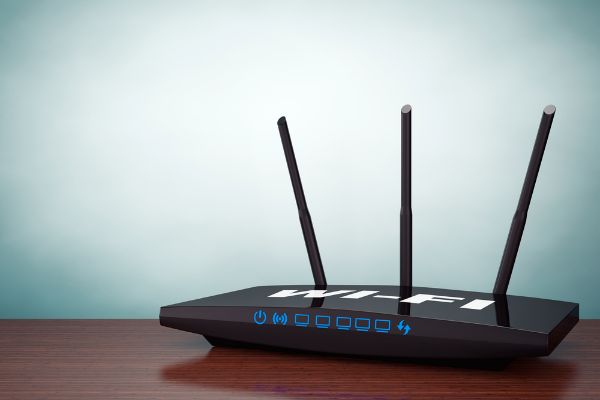Disclaimer: This post may contain affiliate links, meaning we get a small commission if you make a purchase through our links, at no cost to you. For more information, please visit our Disclaimer Page.
The Wi-Fi router is one of the most important components of your home network setup. If you want more than a single device to have an internet connection in your home or business, the router is the piece of tech to which you turn for that to happen.
Even if you did just use one primary device with internet connectivity, you want a way for guests to be able to connect their own devices to your network when they visit. The router makes all of this possible by taking the signal from your internet service provider and dispersing it in a way that allows it to reach multiple devices on just one connection.
Because it plays such a vital role here, some individuals or businesses may be worried about excess heat affecting the router. We will tackle that line of thought here, and we will also see if there is any danger to a router getting too cold. Furthermore, we’ll touch on whether temperatures for the unit could impact internet speeds in some way.
Table of Contents
Does Temperature Affect a Wi-Fi Router?
Temperature can affect a Wi-Fi router if it is exposed to the extremes in either direction for too long. This is not generally the case for most internet-related equipment in a home or office setting. Once you install it in the building, you will leave it indoors.
This setup protects it from the elements of too much heat or cold, and this is particularly true if you set the router up in a climate-controlled environment that manages to stay relatively cool in the hot months and warm during the cold ones.
Even in such settings, it would not be out of the question for your router to become at least warm during its operations. Routers are one of the pieces of tech that people choose to leave on most of the time, and they are active all day and night.
Although routers are designed for this kind of use in order to make sure all devices in a given area are not without a Wi-Fi signal, it is true that some of the internal components could warm up for some time. Some people may choose to unplug their routers at night as a way to alleviate this issue, but it is not strictly necessary to do so.
One of the main reasons temperatures can affect routers is that they are not designed with cooling in mind. A PC or laptop will have cooling elements added to them in order to draw excess heat away from the sensitive electronics and hardware inside the units.
While routers can have components that get warm with use, they don’t reach temperatures that typically require them to make any use of cooling methods. Therefore, if something does happen that causes a drastic shift in temperature around the router, it could affect some of the components inside.
Can a Router Get Too Cold?
Just like any sort of heat, it is technically possible for a router to get too cold in order to function properly. However, that is less likely to happen than a router overheating. In fact, most routers might prefer cooler temps for smoother operations.
The secret here is in how the chips are designed and rated. You can find the specific information when you look at the make and model of your router directly from your manufacturer. However, most chips in routers today are designed to withstand temperatures at least close to freezing, and many of them can handle temperatures somewhat below that mark.
Having said that, there is still a minimum temperature range of which you should be aware. Furthermore, condensation developing on the router itself could prove more of an issue than any cold weather.
If condensation allows moisture droplets to form on the surface of the router, that excess could get into the unit itself and mess up its sensitive components. Therefore, while your router should work fine in colder temps, be mindful of keeping condensation at bay to ensure that it continues to function normally.
If you do need to run a router in temperatures where a cold could be an issue, you might try putting it in a shoebox and making small cutouts for airflow. Doing this might allow the router’s own heat that it gives off as it uses power to keep it warm enough for smooth running. However, this may not be a necessary step.
As for the condensation we mentioned, that should only be a problem if the router’s environment fluctuates quite a bit from cold to warm. These kinds of constant changes can cause condensation to build up and become a problem. If the router is just sitting in a mild or cooler environment, it should be fine.
Do Routers Need To Warm Up?
Because routers can operate at some pretty low temperatures, they shouldn’t need to warm up physically in order to provide your devices with a good signal. This may not be true if the router has been operating well below the minimum recommended temps for which the chips are rated, however.
If this is the case, it is possible that you could notice some sluggish speeds or other problems with the network. Covering it in something that is protective but still allows for good airflow could help.
Otherwise, you can move it to a warmer area to see if there is an improvement. If you choose the latter, it is a good idea to be mindful of that condensation that we mentioned earlier.
In another sense, your router will need time to “warm up” if it is switched off or has been unplugged for a while. The device will need a minute or two to power itself on fully.
During this process, it needs to communicate with your modem, get some information from your internet service provider by way of the modem, and make sure the Wi-Fi network you’ve set up is restored to its full functionality.
Can a Hot Router Cause Slow Internet?
A router that is operating in temperatures well above those rated for its chips could get hot enough to cause slow internet. Remember, most routers like cooler temps for smooth operations.
If you need to run a router in an environment that is very hot, this sustained temperature in concert with the heat it generates on its own could come together in a way that impacts the components inside negatively. If things get too hot inside, the router could experience processing issues or memory errors.
These kinds of things may, in turn, slow the overall speed of your connection. You may also experience frequent drops in the connection altogether. As long as you’re operating the router within the expected range set forth by your manufacturer, there should be minimal risk of this.
Is It Normal for a Router To Get Hot?
Yes and no. If you have a router that has been running continuously for at least a few days, it is definitely normal for it to feel warm when you touch it. In some cases, it may even feel slightly hot when you touch it with your bare hand. These are all signs that the router is probably fine and operating within normal parameters.
If your router feels so warm that it is uncomfortable to touch for any length of time, this may be a sign that it is too hot. Here, you should start by unplugging it and leaving it alone for a while so that it can stop running and cool down. This may be all that is necessary to help the router, but it could depend on the kind of environment in which it runs.
If you still find that the router is feeling too hot when you start it back up, consider running some diagnostics to see if there is any indication that there is a hardware fault going on that could lead to failure. Check the physical connections as well, making sure they are snug and have no loose or frayed wiring.
Although routers don’t tend to have their own cooling methods, you can make them. A small fan that can pass some air over the router might be a good idea. You can also place a typical laptop cooling pad underneath the router, and it will do the same for that device as it does for a computer.
As long as there isn’t any kind of fault inside causing some overheating issue, one of these fixes should suffice.
Can You Leave a Router Outside?
As long as you can maintain a temperature range that is within the limits of the router, it should be okay to leave it outside. This does come with some caveats, and you’ll want to protect the device from inclement weather.
You definitely do not want it to get rained or snowed on, so make sure that it has some kind of enclosure to keep moisture off of it. High humidity can also carry a lot of moisture content through the air, so you should make sure the router has some protection even if you aren’t in a rainy or snowy season.
Conclusion
Router temperatures can affect their performances. Luckily, most manufacturers build chips that can take on a pretty wide range of temperatures with ease. The routers can get too hot or cold, but they’ll be in controlled, shielded environments most of the time. For those rare instances where you have to leave a router outside, some adequate protection should be enough to keep weather at bay and allow it to function normally.


